Identification of Barriers and Drivers of Multifactor Flows in Smart Urban–Rural Networks: An Integrated Geospatial Analytics Framework
Abstract
Highlights
- What are the main findings?
- Urban–rural factor flows in Huzhou exhibit a heterogeneous core–periphery structure, spatially modulated by metropolitan spillovers from Hangzhou and Suzhou.
- Key nodes can simultaneously act as facilitators and obstacles to different flows, revealing a complex, non-binary pattern of integration and barriers.
- What is the implication of the main finding?
- Effective regional governance requires factor-specific and node-sensitive strategies.
- The integrated geospatial analytic framework offers a replicable tool for flow–barrier synergy diagnostics in small and medium-sized cities.
Abstract
1. Introduction
2. Methods
2.1. Study Area
2.2. Research Framework
2.3. Data and Processing
2.4. Theoretical Framework of Urban–Rural Factor Flows
2.5. Measurement of Urban–Rural Factor Flows
2.6. Detection of Barriers to Urban–Rural Factor Flows
2.7. Identification of Driving Factors
3. Results
3.1. Patterns of Urban–Rural Factor Flows
3.1.1. Single Factor Flow
3.1.2. Integrated Flow
3.2. The Barriers to Urban–Rural Factor Flows
3.2.1. Simulated Flow
3.2.2. The Barriers to Single-Factor Flows
3.2.3. The Barriers to Integrated Factor Flows
3.3. Factors Influencing Urban–Rural Factor Flows in Huzhou City
3.3.1. Impact Mechanisms of Single-Factor Flows
3.3.2. Impact Mechanisms of Integrated Factor Flows
4. Discussion
4.1. Heterogeneous Core–Periphery Structures of Urban–Rural Factor Flows
4.2. The Complex Interplay of Urban–Rural Factor Flows and Barriers
4.3. Multifactor Synergistic Effects and Key Drivers of Urban–Rural Factor Flows
4.4. Policy Implications
5. Conclusions
Author Contributions
Funding
Data Availability Statement
Conflicts of Interest
References
- Niu, B.; Ge, D.Z.; Sun, J.W.; Sun, D.Q.; Ma, Y.Y.; Ni, Y.L.; Lu, Y.Q. Multi-scales urban-rural integrated development and land-use transition: The story of China. Habitat Int. 2023, 132, 102744. [Google Scholar] [CrossRef]
- Zhang, C.; Fan, Y.P.; Fang, C.L. Orderly and synergistic development of urban-rural integration based on evolutionary game model: A case study in the Jiangxi Province, China. Land Use Policy 2024, 146, 107331. [Google Scholar] [CrossRef]
- Chen, X.; Wu, R. How can rural industrial revitalization and rural education level reduce the urban–rural income gap? Financ. Res. Lett. 2025, 73, 106592. [Google Scholar] [CrossRef]
- Li, Y.X.; Liao, C.C.; Li, X.M.; Guo, R.Z. Understanding regional structure through spatial networks: A simulation optimization framework for exploring balanced development. Habitat Int. 2024, 152, 103155. [Google Scholar] [CrossRef]
- Liu, Y.; Li, Y. Revitalize the world’s countryside. Nature 2017, 548, 275–277. [Google Scholar] [CrossRef]
- Xinhua News Agency. Communique of the Third Plenary Session of the 20th Central Committee of the Communist Party of China. Available online: https://www.gov.cn/yaowen/liebiao/202407/content_6963409.htm (accessed on 18 July 2024).
- Lynch, K. Rural-Urban Interaction in the Developing World; Taylor & Francis: Abingdon, UK, 2004. [Google Scholar]
- Tacoli, C. The links between urban and rural development. Environ. Urban. 2003, 15, 3–12. [Google Scholar] [CrossRef]
- Tacoli, C. Rural-urban interactions: A guide to the literature. Environ. Urban. 1998, 10, 147–166. [Google Scholar] [CrossRef]
- Lewis, A. Economic Development with Unlimited Supplies of Labour. Manch. Sch. Econ. Soc. Stud. 1954, 22, 139–191. [Google Scholar]
- Todaro, M.P. A Model of Labor Migration and Urban Unemployment in Less Developed Countries. Am. Econ. Rev. 1969, 59, 138–148. [Google Scholar]
- Mcgee, T.G. Chapter 1 The Emergence of Desakota Regions in Asia: Expanding a Hypothesis. In The Extended Metropolis; Norton, G., Bruce, K., McGee, T.G., Eds.; University of Hawaii Press: Honolulu, HI, USA, 1991; pp. 1–26. [Google Scholar]
- Castells, M. The Space of Flows. In The Rise of the Network Society; Blackwell Publisher: Cambridge, MA, USA, 1996; pp. 407–459. [Google Scholar]
- Pipere, A.; Martinsone, K. Shaping an Image of Science in the 21st Century: The Perspective of Metamodernism. Societies 2023, 13, 254. [Google Scholar] [CrossRef]
- Matlovic, R.; Matlovicová, K. The Metamodern Shift in Geographical Thought: Oscillatory Ontology and Epistemology, Post-Disciplinary and Post-Paradigmatic Perspectives. Folia Geogr. 2025, 67, 22–69. [Google Scholar]
- Unwin, T. Urban-Rural Interaction in Developing Countries: A Theoretical Perspective. In The Geography of Urban-Rural Interaction in Developing Countries; Routledge: Abingdon, UK, 2017; pp. 11–32. [Google Scholar]
- Lagakos, D. Urban-Rural Gaps in the Developing World: Does Internal Migration Offer Opportunities? J. Econ. Perspect. 2020, 34, 174–192. [Google Scholar] [CrossRef]
- Cattaneo, A.; Nelson, A.; McMenomy, T. Global mapping of urban-rural catchment areas reveals unequal access to services. Proc. Natl. Acad. Sci. USA 2021, 118, e2011990118. [Google Scholar] [CrossRef]
- Pan, W.; Wang, J.; Li, Y.R.; Chen, S.T.; Lu, Z. Spatial pattern of urban-rural integration in China and the impact of geography. Geogr. Sustain. 2023, 4, 404–413. [Google Scholar] [CrossRef]
- Temenos, C. Minor theory and relational urbanism. Environ. Plan. D Soc. Space 2017, 35, 579–583. [Google Scholar] [CrossRef]
- Douglass, M. A Regional Network Strategy for Reciprocal Rural-Urban Linkages: An Agenda for Policy Research with Reference to Indonesia. Third World Plan. Rev. 1998, 20, 1–33. [Google Scholar] [CrossRef]
- Sheller, M.; Urry, J. The new mobilities paradigm. Environ. Plan. A Econ. Space 2006, 38, 207–226. [Google Scholar] [CrossRef]
- Sandow, E. Commuting behaviour in sparsely populated areas: Evidence from northern Sweden. J. Transp. Geogr. 2008, 16, 14–27. [Google Scholar] [CrossRef]
- Pan, M.; Li, W.; Wang, C. From roads to roofs: How urban and rural mobility influence building energy consumption. Energy Res. Soc. Sci. 2024, 118, 103800. [Google Scholar] [CrossRef]
- Cheng, M.; Yin, Z.; Westlund, H. Counterurbanization in China? A case study of counties in Huang-Huai-Hai area from the perspective of urban-rural relations. J. Rural Stud. 2024, 110, 103386. [Google Scholar] [CrossRef]
- Castillo, G.; Brereton, D. The country and the city: Mobility dynamics in mining regions. Extr. Ind. Soc. Int. J. 2018, 5, 307–316. [Google Scholar] [CrossRef]
- Delmotte, C.; Davidsen, C.; Piccoli, E. Multi-directional migration, land ownership and livelihood strategies in the Peruvian Andes: Conceptualising urban-rural return flows during the COVID-19 pandemic. J. Ethn. Migr. Stud. 2025, 51, 1–19. [Google Scholar] [CrossRef]
- Morrill, R.; Cromartie, J.; Hart, G. Metropolitan, urban, and rural commuting areas: Toward a better depiction of the United States settlement system. Urban Geogr. 1999, 20, 727–748. [Google Scholar] [CrossRef]
- Serlenga, L.; Shin, Y. Gravity models of interprovincial migration flows in Canada with hierarchical multifactor structure. Empir. Econ. 2021, 60, 365–390. [Google Scholar] [CrossRef]
- Shen, C.; Zhang, X.Y.; Li, X. Revisiting the regional sustainable development from the perspective of multi-system factor flows-Evidence in the Yangtze River Delta of China. Heliyon 2023, 9, e18893. [Google Scholar] [CrossRef] [PubMed]
- Itoh, R. Dynamic control of rural–urban migration. J. Urban Econ. 2009, 66, 196–202. [Google Scholar] [CrossRef]
- Kang, Y.H.; Gao, S.; Liang, Y.L.; Li, M.X.; Rao, J.M.; Kruse, J. Multiscale dynamic human mobility flow dataset in the US during the COVID-19 epidemic. Sci. Data 2020, 7, 390. [Google Scholar] [CrossRef]
- Zhang, J.; Yuan, X.D.; Tan, X.P.; Zhang, X. Delineation of the Urban-Rural Boundary through Data Fusion: Applications to Improve Urban and Rural Environments and Promote Intensive and Healthy Urban Development. Int. J. Environ. Res. Public Health 2021, 18, 7180. [Google Scholar] [CrossRef] [PubMed]
- Zhang, J.; Li, L.; Zhu, C.; Hao, Q.; Chen, X.; Yu, Z.; Gan, M.; Li, W. Investigating the Spatial Heterogeneity and Influencing Factors of Urban Multi-Dimensional Network Using Multi-Source Big Data in Hangzhou Metropolitan Circle, Eastern China. Land 2023, 12, 1808. [Google Scholar] [CrossRef]
- Wang, Y. Analysis on the evolution of spatial relationship between population and economy in the Beijing-Tianjin-Hebei and Shandong region of China. Sustain. Cities Soc. 2022, 83, 103948. [Google Scholar] [CrossRef]
- Zheng, X.; Yu, H.; Yang, L. Factor Mobility, Industrial Transfer and Industrial Carbon Emission: A Spatial Matching Perspective. Front. Environ. Sci. 2022, 10, 822811. [Google Scholar] [CrossRef]
- Zhang, J.; Hao, Q.; Chen, X.; Zhu, C.; Zhang, L.; Hong, M.; Wu, J.; Gan, M. Exploring Spatial Network Structure of the Metropolitan Circle Based on Multi-Source Big Data: A Case Study of Hangzhou Metropolitan Circle. Remote Sens. 2022, 14, 5266. [Google Scholar] [CrossRef]
- Zhang, Y.; Chen, Y.; Wang, X.; Gong, J.; Ji, M.; Zhao, J. Level measurement and influencing factors of the obstacle to factor flow in the Chengdu-Chongqing Economic Circle. J. Nat. Resour. 2024, 39, 897–911. [Google Scholar] [CrossRef]
- Du, W.; Zhang, Q.; Chen, Y.; Ye, Z. An urban short-term traffic flow prediction model based on wavelet neural network with improved whale optimization algorithm. Sustain. Cities Soc. 2021, 69, 102858. [Google Scholar] [CrossRef]
- Zhou, D.; Qi, J.; Zhong, W.; Wang, J. Urban and rural integration development in urban agglomerations: Measurement and evaluation, obstacle factors and driving factors. Geogr. Res. 2023, 42, 2914–2939. [Google Scholar] [CrossRef]
- Yenneti, K.; Day, R.; Golubchikov, O. Spatial justice and the land politics of renewables: Dispossessing vulnerable communities through solar energy mega-projects. Geoforum 2016, 76, 90–99. [Google Scholar] [CrossRef]
- Zhou, M.; Lyu, H.Y. Intensifying separation or collaborative prosperity? The impact of The Belt and Road Initiative on China’s urban-rural integration development from a spatial justice lens. Habitat Int. 2025, 156, 103249. [Google Scholar] [CrossRef]
- Wei, S.Y.; Huang, J.; Zhang, Z.L. The Impact of Land Development Rights Transfer on Urban-Rural Spatial Justice: A Case Study of Chongqing’s Land Quota Trading. Land 2025, 14, 174. [Google Scholar] [CrossRef]
- Bittner, C.; Sofer, M. Land use changes in the rural–urban fringe: An Israeli case study. Land Use Policy 2013, 33, 11–19. [Google Scholar] [CrossRef]
- Haller, A. The “sowing of concrete”: Peri-urban smallholder perceptions of rural–urban land change in the Central Peruvian Andes. Land Use Policy 2014, 38, 239–247. [Google Scholar] [CrossRef]
- Scoones, I. Livelihoods perspectives and rural development. J. Peasant Stud. 2009, 36, 171–196. [Google Scholar] [CrossRef]
- Taylor, J.E.; Martin, P.L. Human Capital: Migration and Rural Population Change. Handb. Agric. Econ. 2001, 1, 457–511. [Google Scholar]
- Zhuo, C.; Xie, Y.; Mao, Y.; Chen, P.; Li, Y. Can cross-regional environmental protection promote urban green development: Zero-sum game or win-win choice? Energy Econ. 2022, 106, 105803. [Google Scholar] [CrossRef]
- Peng, S.; Liang, S.; Dai, T.; Peng, H. Exploring the Mechanisms of Regional Environmental Collaborative Legislation in China: Policy Effectiveness, Practical Challenges, and Policy Suggestions. Sustainability 2024, 16, 3959. [Google Scholar] [CrossRef]
- Ma, L.; Liu, S.; Fang, F.; Che, X.; Chen, M. Evaluation of urban-rural difference and integration based on quality of life. Sustain. Cities Soc. 2020, 54, 101877. [Google Scholar] [CrossRef]
- Sun, S.; Zhang, N.-N.; Liu, J.-B. Study on the Rural Revitalization and Urban-Rural Integration Efficiency in Anhui Province Based on Game Cross-Efficiency DEA Model. Comput. Intell. Neurosci. 2022, 2022, 7373435. [Google Scholar] [CrossRef] [PubMed]
- Yuan, Z.; Ge, D.; Sun, P.; Tang, S.; Li, Y. Measurement and optimization paths of regional attraction under the background of population shrinkage:Taking the townships of Jiangsu Province as an example. Prog. Geogr. 2024, 43, 1074–1087. [Google Scholar] [CrossRef]
- Zhao, W.Y.; Pan, W.; Li, Y.R. Urban-rural integration within the county territory: Theoretical connotation and research progress. Geogr. Res. 2023, 42, 1445–1464. [Google Scholar] [CrossRef]
- Ding, L.; Wang, Y.H.; Zhang, X.C.; Zhang, J.S. The Latest Progress in Social Space Research and Its Implications for Urban and Rural Planning Study in China. Urban Plan. Int. 2025, 1–14. [Google Scholar] [CrossRef]
- Jin, W.C.; Wang, X.; He, A.H. Promoting Integrated Urban-rural Development: Experiences, Challenges, and Responses. Issues Agric. Econ. 2025, 02, 4–14. [Google Scholar] [CrossRef]
- Yang, J.; Ge, D.Z.; Sun, P.; Yuan, Z.Y. The mechanism of urban-rural integrated development based on the “population-land-capital” factor flow:A case study of Jiangxi Province. Resour. Sci. 2025, 47, 110–124. [Google Scholar] [CrossRef]
- Taylor, P.J.; Evans, D.M.; Pain, K. Application of the interlocking network model to mega-city-regions: Measuring polycentricity within and beyond city-regions. Reg. Stud. 2008, 42, 1079–1093. [Google Scholar] [CrossRef]
- Shahriar, S.; Qian, L.; Kea, S. Determinants of Exports in China’s Meat Industry: A Gravity Model Analysis. Emerg. Mark. Financ. Trade 2019, 55, 2544–2565. [Google Scholar] [CrossRef]
- Wang, J.; Xu, C. Geodetector: Principle and prospective. Acta Geogr. Sin. 2017, 72, 116–134. [Google Scholar] [CrossRef]
- Zhang, J.; Guan, C.Y.; Zhang, L.; Yu, Z.L.; Ye, C.X.; Zhu, C.M.; Li, S.N.; Wang, K.; Gan, M.Y. Spatial identification and evaluation of rural vitality from a function-element-flow perspective: Evidence of Lin’an district in Hangzhou, China. J. Geogr. Sci. 2024, 34, 1228–1250. [Google Scholar] [CrossRef]
- Zhang, X.W.; Fang, C.L.; Ma, H.T.; Hu, X.Q. How does digital economy affect urban-rural integration? An empirical study from China. Habitat Int. 2024, 154, 103229. [Google Scholar] [CrossRef]
- Tian, S.Z.; Jiang, J.L.; Li, H.; Li, X.M.; Yang, J.; Fang, C.L. Flow space reveals the urban network structure and development mode of cities in Liaoning, China. Humanit. Soc. Sci. Commun. 2023, 10, 257. [Google Scholar] [CrossRef]
- Zhou, Y.; Zheng, W.; Wang, X. Economic efficiency of the Wuhan metropolitan area under the interaction of urban hierarchy and population flow. Prog. Geogr. 2025, 44, 64–76. [Google Scholar]
- Wang, X.M.; Ding, Z.W. Analysis of network patterns and its influencing factors in Chengdu-Chongqing urban agglomeration based on multi-flow. Heliyon 2024, 10, e30375. [Google Scholar] [CrossRef] [PubMed]
- Xu, Z.M.; Lin, G.C.S. Financializing Shanghai: Entrepreneurial Urban Governance and the Changing Mechanisms of Urban Redevelopment under State-Led Financialized Urbanism. J. Plan. Educ. Res. 2025, 0739456X241306767. [Google Scholar] [CrossRef]
- Sun, X.Q.; Xiang, P.C.; Dong, N.D.; Sui, H.J.; Bo, Z. Can transportation networks contribute to the sustainable development of urban agglomeration spatial structures? Sustain. Cities Soc. 2024, 117, 105983. [Google Scholar] [CrossRef]
- Xu, J.; Qiu, Y.D.; Rahman, M.K.; Bhuiyan, M.A.; Hasan, T. The Regional Economic Spatial Spillover Effect of China and ASEAN. J. Ind. Compet. Trade 2025, 25, 1–19. [Google Scholar] [CrossRef]
- Yuan, T.; Xiang, Y.J.; Xiong, L.X. Driving forces and obstacles analysis of urban high-quality development in Chengdu. Sci. Rep. 2024, 14, 24530. [Google Scholar] [CrossRef]
- Li, X.M.; Gao, M.K.; Li, H.; Hou, X.Y.; Tian, S.Z.; Yang, J.; Zhang, X.H. Spatio-temporal evolution and obstacle diagnosis of human settlements based on the “production-living-ecological” functions. Sci. Rep. 2024, 14, 31022. [Google Scholar] [CrossRef]
- Zheng, L.; Liu, Y. Digital economy, agricultural loans, and urban–rural income gap. Financ. Res. Lett. 2025, 77, 107034. [Google Scholar] [CrossRef]
- Qian, X.; Wang, Y.; Zhang, G. The spatial correlation network of capital flows in China: Evidence from China’s High-Value Payment System. China Econ. Rev. 2018, 50, 175–186. [Google Scholar] [CrossRef]
- Yuan, Q.; Wang, J. Goods movement, road safety, and spatial inequity: Evaluating freight-related crashes in low-income or minority neighborhoods. J. Transp. Geogr. 2021, 96, 103186. [Google Scholar] [CrossRef]
- Zhang, W.; Chong, Z.; Li, X.; Nie, G. Spatial patterns and determinant factors of population flow networks in China: Analysis on Tencent Location Big Data. Cities 2020, 99, 102640. [Google Scholar] [CrossRef]
- Zhao, P.; Xintao, L.; Wenzhong, S.; Tao, J.; Wengen, L.; Chen, M. An empirical study on the intra-urban goods movement patterns using logistics big data. Int. J. Geogr. Inf. Sci. 2020, 34, 1089–1116. [Google Scholar] [CrossRef]
- Cui, X.; Shi, Y.; Ma, H.; Miao, Y. Research progress and prospects of coordinated development of the Guangdong-Hong Kong-Macao Greater Bay Area. Geogr. Geo-Inf. Sci. 2025, 41, 97–107. [Google Scholar]
- Kourtidou, K.; Frangopoulos, Y.; Salepaki, A.; Kourkouridis, D. Digital Inequality and Smart Inclusion: A Socio-Spatial Perspective from the Region of Xanthi, Greece. Smart Cities 2025, 8, 123. [Google Scholar] [CrossRef]
- Xu, N.; Zhang, X.; Wang, P. Public Vitality-Driven Optimization of Urban Public Space Networks—A Case Study from Nanjing, China. Smart Cities 2025, 8, 18. [Google Scholar] [CrossRef]
- Ming, Y.J.; Liu, Y.; Li, Y.P.; Yue, W.Z. Core-periphery disparity in community vitality in Chongqing, China: Nonlinear explanation based on mobile phone data and multi-scale factors. Appl. Geogr. 2024, 164, 103222. [Google Scholar] [CrossRef]
- Fang, X.Q.; Su, D.; Wu, Q.; Wang, J.Y.; Zhang, Y.J.; Li, G.Y.; Cao, Y. Dynamic changes in urban land spatial inequality under the core-periphery structure in urban agglomerations. J. Geogr. Sci. 2023, 33, 760–778. [Google Scholar] [CrossRef]
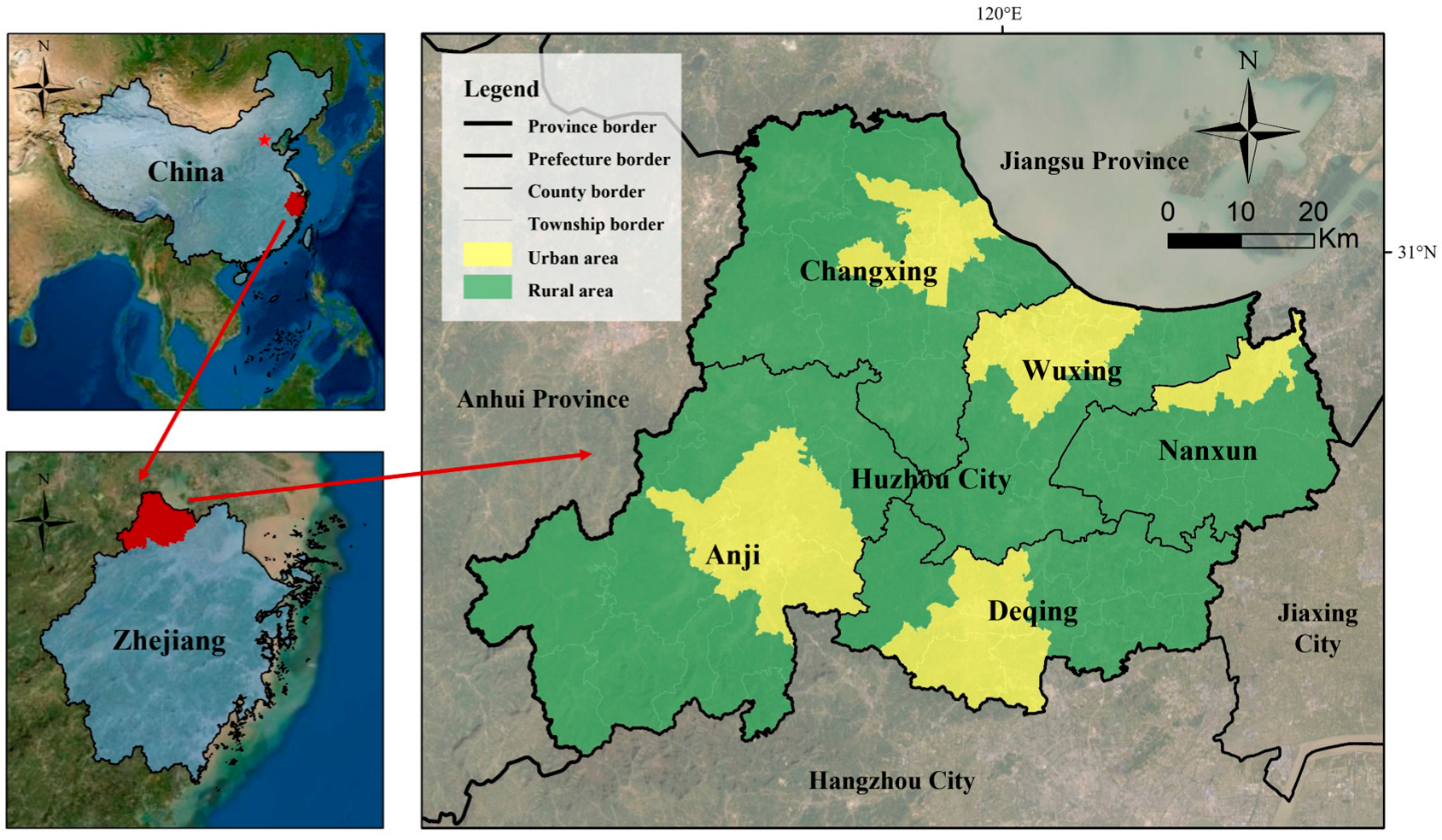

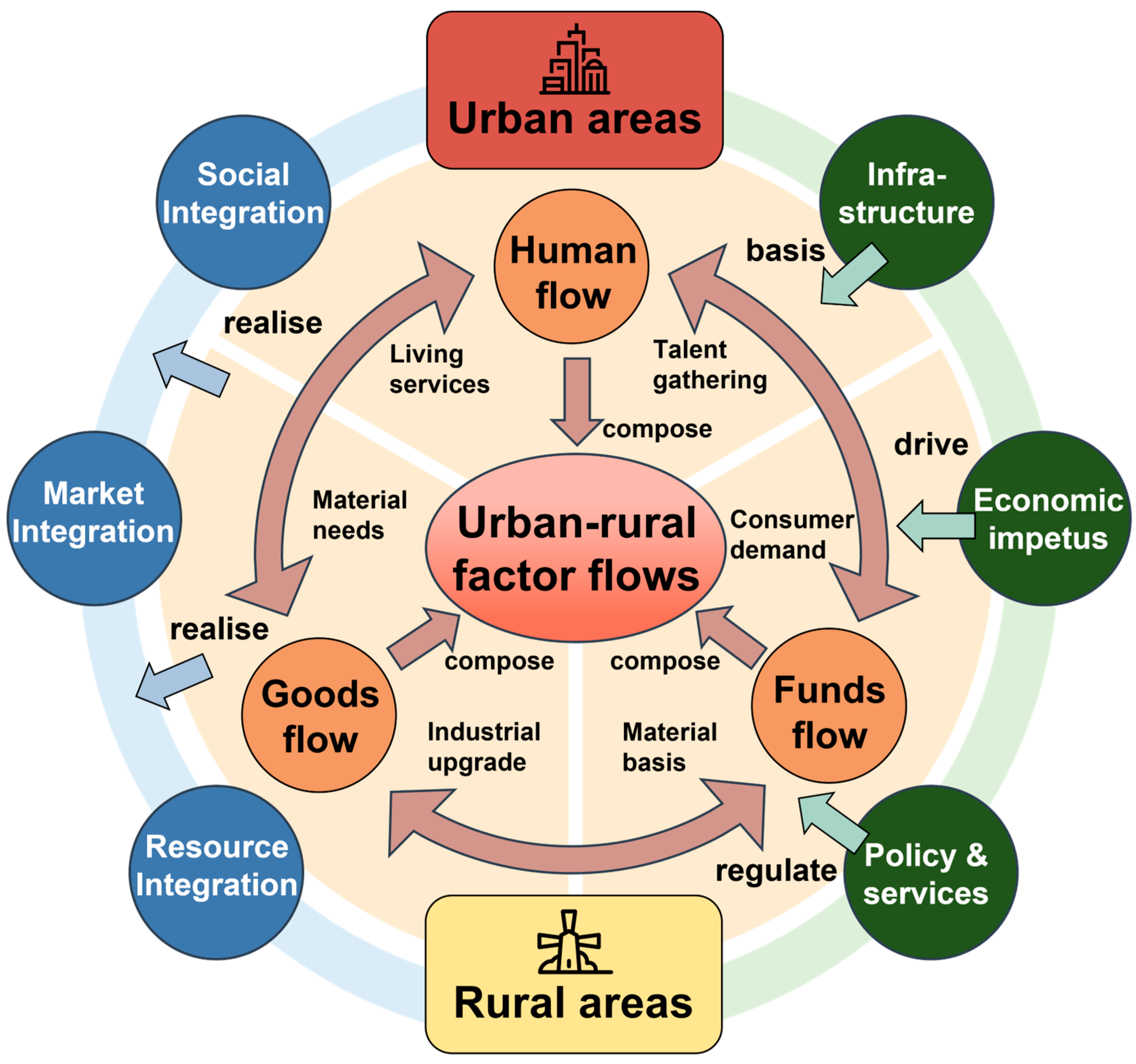

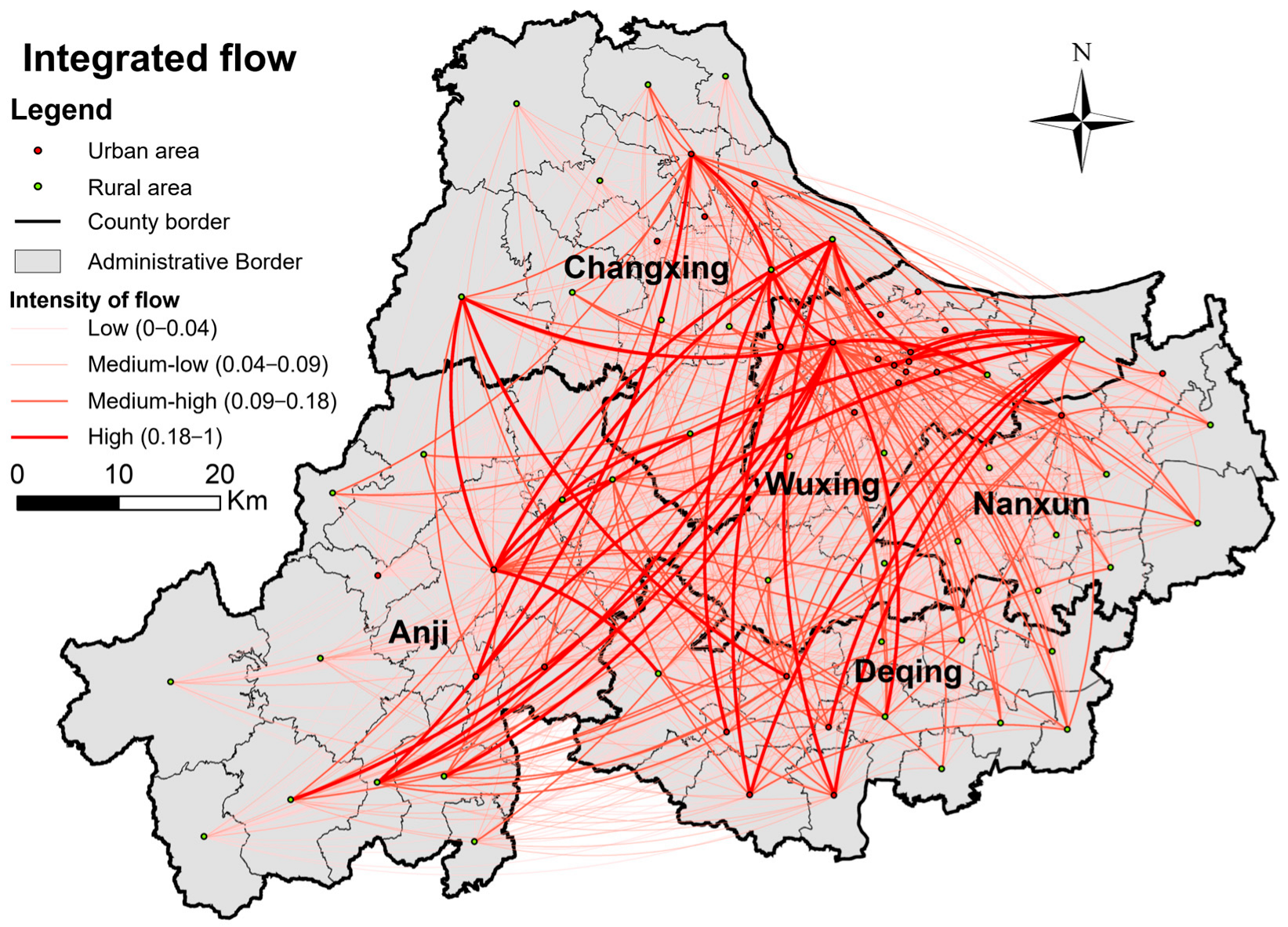

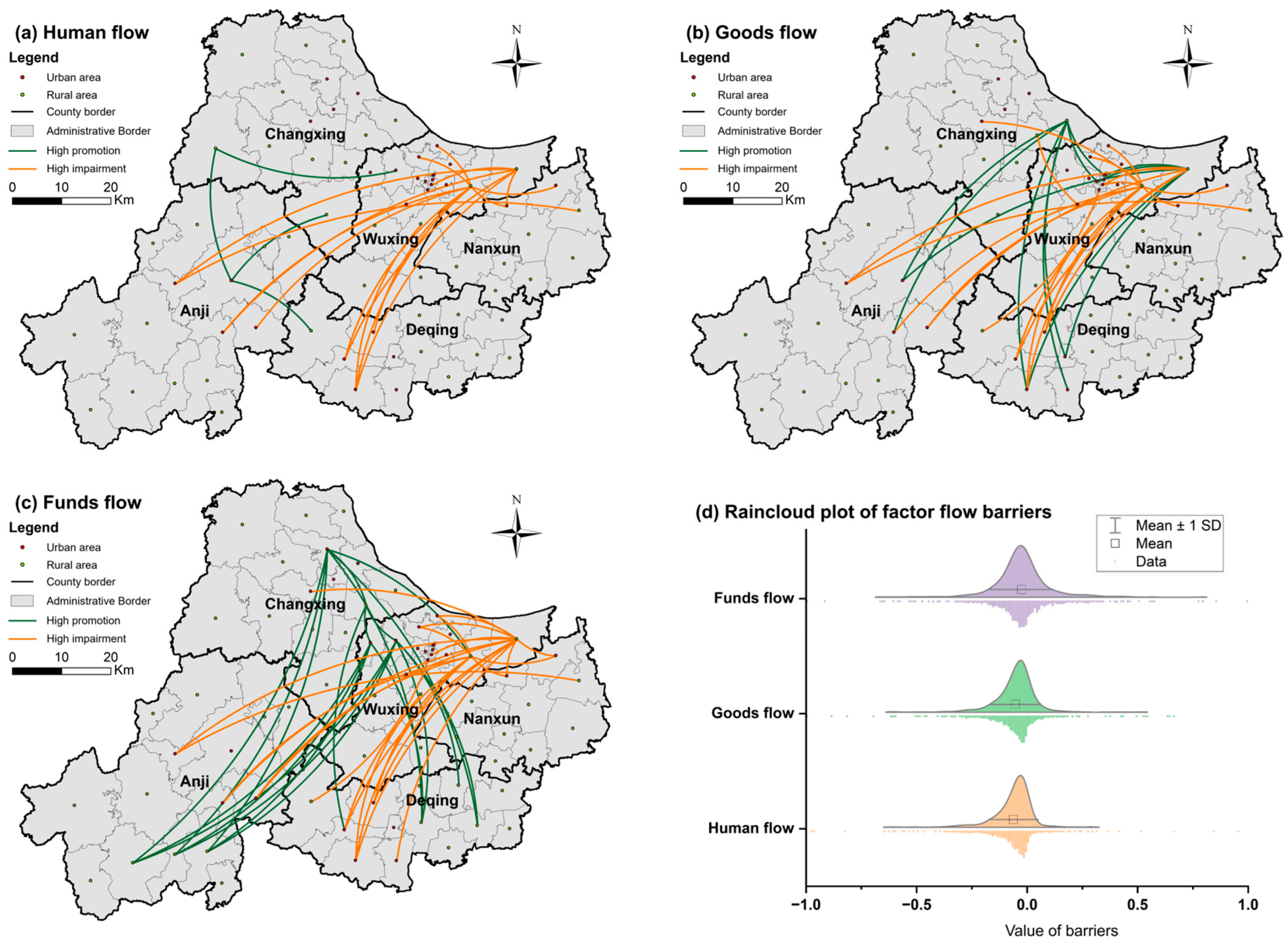

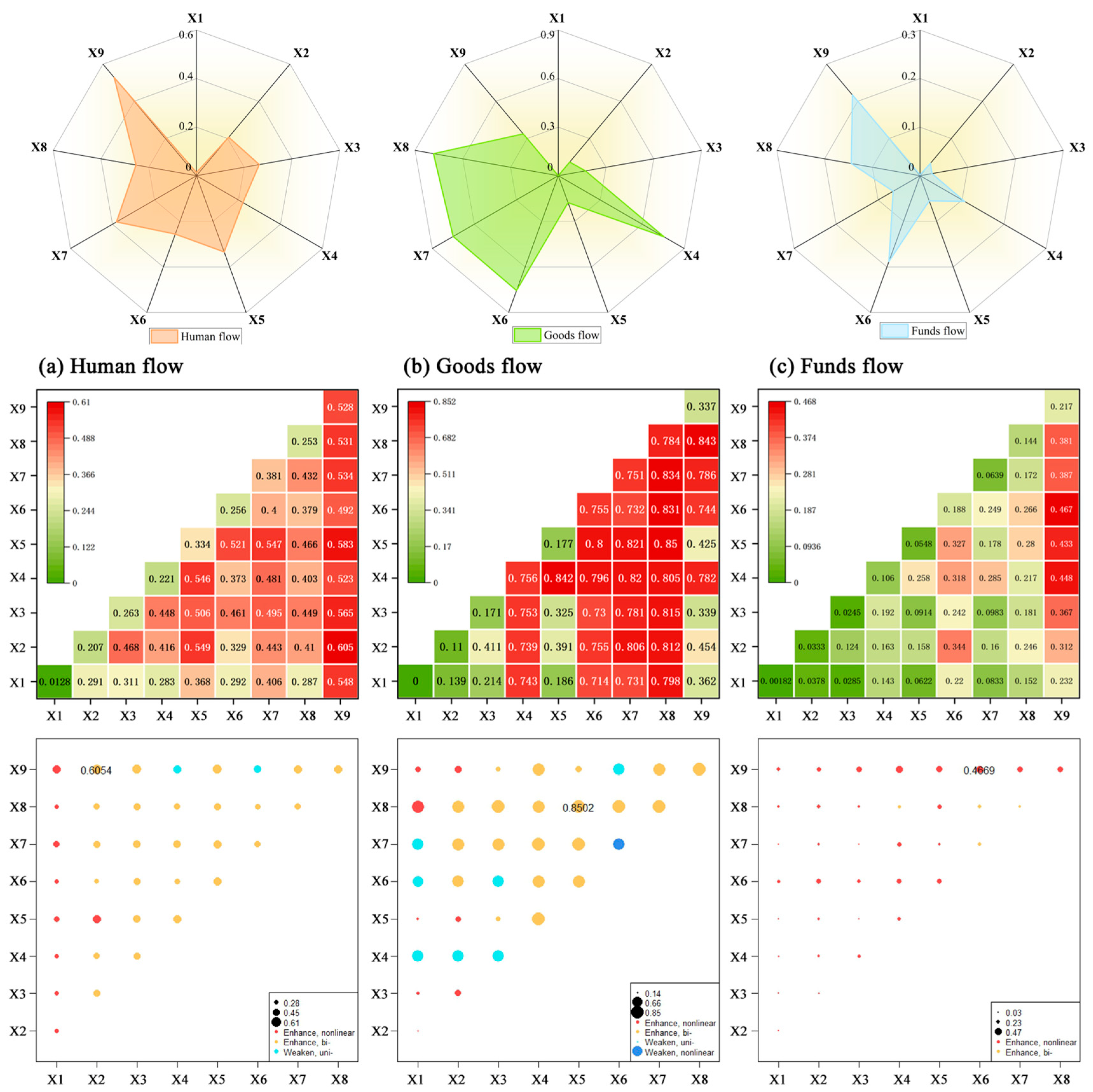
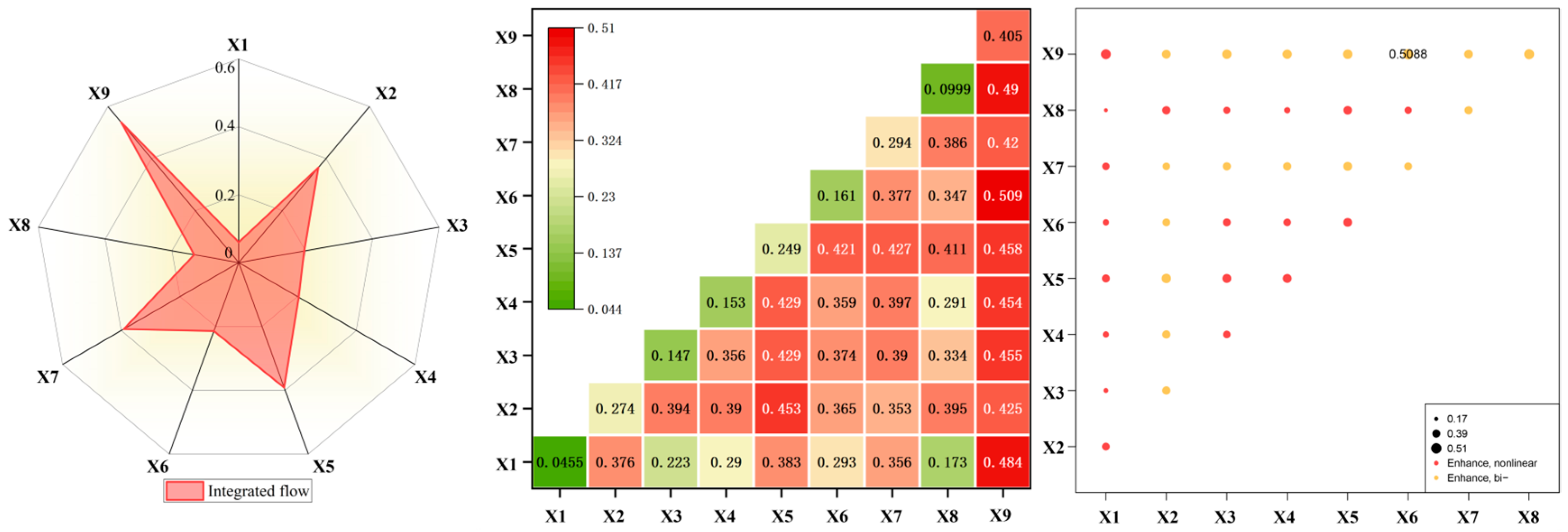
| Factor Code | Driving Factors | Explanation |
|---|---|---|
| X1 | Administrative divisions | Whether township i and subdistrict j are in the same county |
| X2 | Companies | Sum of the number of firms in the area of township i and subdistrict j |
| X3 | Scenic spots | Sum of the number of scenic spots in the area of township i and subdistrict j |
| X4 | Medical facilities | Sum of the number of medical facilities in the area of township i and subdistrict j |
| X5 | Transport mileage | Sum of road and railway mileage in the area of township i and subdistrict j |
| X6 | Educational facilities | Sum of the number of educational facilities in the area of township i and subdistrict j |
| X7 | Shopping services | Sum of the number of shopping service facilities in the area of township i and subdistrict j |
| X8 | Living services | Sum of the number of living services facilities in the area of township i and subdistrict j |
| X9 | Economic vitality | Sum of the night light index in the area of township i and subdistrict j |
| Levels | Human Flow | Goods Flow | Funds Flow |
|---|---|---|---|
| High promotion | 0.41~1 | 0.27~1 | 0.37~1 |
| Medium promotion | 0.13~0.41 | 0.08~0.27 | 0.13~0.37 |
| Low promotion | 0~0.13 | 0~0.08 | 0~0.13 |
| Low impairment | −0.12~0 | −0.11~0 | −0.11~0 |
| Medium impairment | −0.42~−0.12 | −0.38~−0.11 | −0.37~−0.11 |
| High impairment | −1~−0.42 | −1~−0.38 | −1~−0.37 |
| Driving Factor | Human Flow | Goods Flow | Funds Flow |
|---|---|---|---|
| X1 | 0.013 *** | 0.000 | 0.002 *** |
| X2 | 0.207 *** | 0.110 *** | 0.033 *** |
| X3 | 0.263 *** | 0.171 *** | 0.025 *** |
| X4 | 0.221 *** | 0.756 *** | 0.106 *** |
| X5 | 0.334 *** | 0.177 *** | 0.055 *** |
| X6 | 0.256 *** | 0.755 *** | 0.188 *** |
| X7 | 0.381 *** | 0.751 *** | 0.064 *** |
| X8 | 0.253 *** | 0.784 *** | 0.144 *** |
| X9 | 0.528 *** | 0.337 *** | 0.217 *** |
| Driving Factor | Level of Impact |
|---|---|
| X1 | 0.045 *** |
| X2 | 0.274 *** |
| X3 | 0.147 *** |
| X4 | 0.153 *** |
| X5 | 0.294 *** |
| X6 | 0.161 *** |
| X7 | 0.294 *** |
| X8 | 0.100 *** |
| X9 | 0.405 *** |
Disclaimer/Publisher’s Note: The statements, opinions and data contained in all publications are solely those of the individual author(s) and contributor(s) and not of MDPI and/or the editor(s). MDPI and/or the editor(s) disclaim responsibility for any injury to people or property resulting from any ideas, methods, instructions or products referred to in the content. |
© 2025 by the authors. Licensee MDPI, Basel, Switzerland. This article is an open access article distributed under the terms and conditions of the Creative Commons Attribution (CC BY) license (https://creativecommons.org/licenses/by/4.0/).
Share and Cite
Zhang, J.; Ye, C.; Chen, X.; Cai, Y.; Zhu, C.; Ren, F.; Gan, M. Identification of Barriers and Drivers of Multifactor Flows in Smart Urban–Rural Networks: An Integrated Geospatial Analytics Framework. Smart Cities 2025, 8, 162. https://doi.org/10.3390/smartcities8050162
Zhang J, Ye C, Chen X, Cai Y, Zhu C, Ren F, Gan M. Identification of Barriers and Drivers of Multifactor Flows in Smart Urban–Rural Networks: An Integrated Geospatial Analytics Framework. Smart Cities. 2025; 8(5):162. https://doi.org/10.3390/smartcities8050162
Chicago/Turabian StyleZhang, Jing, Chengxuan Ye, Xinming Chen, Yuchao Cai, Congmou Zhu, Fulong Ren, and Muye Gan. 2025. "Identification of Barriers and Drivers of Multifactor Flows in Smart Urban–Rural Networks: An Integrated Geospatial Analytics Framework" Smart Cities 8, no. 5: 162. https://doi.org/10.3390/smartcities8050162
APA StyleZhang, J., Ye, C., Chen, X., Cai, Y., Zhu, C., Ren, F., & Gan, M. (2025). Identification of Barriers and Drivers of Multifactor Flows in Smart Urban–Rural Networks: An Integrated Geospatial Analytics Framework. Smart Cities, 8(5), 162. https://doi.org/10.3390/smartcities8050162





